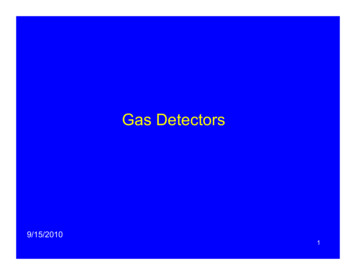
Transcription
NEUTRON SOURCES10/13/20101
General2
GeneralNeutron Properties Composition: two down quarks and one up quarkRest Mass: 1.0086649 amuEnergy equivalent: 939.5656 MeVElectric charge: 0Half-life: 10.4 minutes (outside the nucleus)Decay scheme:neutron proton beta antineutrino3
GeneralUses of NeutronsReactor start upDensity gaugesMoisture gaugesWell loggingActivation analysisGemstone colorizationRadiographyResearch (physics, medicine)Triggers for nuclear weaponsInstrument calibration4
GeneralNeutron Fluence Rate The intensity of a neutron source is usuallydescribed by the fluence rate This is often and incorrectly referred to as the flux The neutron fluence rate (N) is the number ofneutrons that pass through a specified area perunit time. Commonly employed units for thisquantity are n/cm2/s (i.e., cm-2 s-1). The directionof the neutrons is irrelevant.5
GeneralTypes of Neutron Sources Alpha neutron sources Gamma neutron sources Spontaneous fission neutron sources Fission reactors Accelerators6
GeneralMeasuring the Neutron Source Strength The neutron emission rates for alpha neutron,gamma neutron, and spontaneous fissionneutron sources can be determined with themanganese sulfate bath technique. The source is positioned in the center of a tankfilled with a solution of manganese sulfate (thebath must be large enough to moderate all theneutrons). By quantifying the Mn-56 (2.6 hr)production via gamma spectrometry, the neutronemission rate can be calculated.7
GeneralMeasuring the Neutron Source StrengthThe manganese solution isinside the spherical tank andthe source is lowered throughthe top.Image courtesy of NPL.The white neutron detector onthe right side of the tank isused to measure neutronleakage. This value is used tomake corrections to thecalculated neutron emissionrate.8
ALPHA NEUTRON SOURCES9
Alpha Neutron SourcesGeneral Alpha neutron sources are the most commonlyencountered type of neutron source. An alpha emitter is intimately mixed with a low Zmaterial, usually Be-9.Be-9 " ÿ C-12 neutron 4.44 MeV ( The source strength is specified by the activity ofthe alpha emitter. Activities of 0.5 to 40 Ci (18.5GBq to 1.48 TBq) are common although portabledensity gauges might employ 10 to 50 mCi (0.37to 1.85 GBq) sources .10
Alpha Neutron SourcesGeneral Alpha emitters used in neutron sources includeAm-241, Pu-238, Pu-239, Po-210, Ra-226 The “most important” is Am-241. Plutoniumsources are also common. One possible concern with these sources is thepotential for the build-up of pressure due to heliumproduction.11
Alpha Neutron SourcesAmBe Sources AmBe (“ambee”) sources are a mix of Am-241 andBe-9. Yield: ca. 2.0 to 2.4 x 106 neutrons/sec. per Cica 5ca.5.44 to 6.56 5 x 104 neutrons/sec.neutrons/sec per GBq Half-life: 432.2 years Average neutron energy: 4.2 MeV (11 max) Neutron dose rate: 2.2-2.7 mrem/hr at 1 m/Ci0.59-0.73 uSv/hr at 1m/GBq Gamma dose rate: 2.5 mrem/hr at 1 m/Ci0.68 uSv/hr at 1m/GBq12
Alpha Neutron SourcesPuBe Sources PuBe (“pewbee”) sources are a mix of Pu-239 orPu-238 and Be-9. Yield: ca. 1.5 to 2.0 x 106 neutrons/second per Cica 4 to 5.4ca.5 4 x 104 neutrons/second per GBq Half-life: 24,114 years Average neutron energy: 4.2 – 5 MeV (11 max) Neutron dose rate: 1.3-2.7 mrem/hr at 1 m/Ci0.35-0.73 uSv/hr at 1m/GBq Gamma dose rate: 0.1 mrem/hr at 1 m/Ci0.027 uSv/hr at 1 m/GBq13
Alpha Neutron SourcesRaBe Sources RaBe (“raybee”) source, a mix of Ra-226 and Be-9 Yield: ca. 15 x 106 neutrons/sec. per Cica. 40 x 104 neutrons/sec. per GBq Half-life: 1,600 years Average neutron energy: 3.6 MeV (13.2 MeV max) Gamma exposure rates of these sources can behigh. There is also the problem of leakage. RaBesources have been used in moisture gauges sold bySeaman Nuclear - until recently radium has beenunregulated by the NRC.14
Alpha Neutron SourcesAlternatives to Beryllium Beryllium is the most common low Z material to beused in alpha-neutron sources because of itsrelatively high neutron yield. Nevertheless, fluorine, lithium and boron have alsobeen used. Am-F and Am-Li sources have average neutronenergies of 1.5 and 0.5 MeV respectively.15
Alpha Neutron SourcesNeutron Yield The neutron yield (n/s) of a particular source canonly be determined precisely by measurement Yield values expressed as n/s/Ci are onlyestimates. The actual yield depends on the sourceconstruction and the beryllium - alpha emitter ratio.16
Alpha Neutron SourcesSource Construction The alpha emitter and beryllium must be inintimate contact, e.g., by mixing powderedberyllium metal with an oxide of the alpha emitter.This mixture is then compressed into a cylindricalyshape for encapsulation. Another approach is toemploy a metallic alloy of the beryllium and thealpha emitting actinide.Typical AmBe sources.Largest pictured is 60 x 30mm. Image courtesy of NPL.17
Alpha Neutron SourcesSource Construction The source is doublyencapsulated. The inner andouter capsules are usuallyfabricated of stainless steel (type304) and the end caps are TIGwelded. Space is left within theinner capsule to allow for thegradual buildup of helium thatresults from the alpha emissions.18
Alpha Neutron SourcesNeutron EnergiesThe energies usuallyrange up to 11 MeVwith an average energybetween 4 and 5 MeV.19
GAMMA-NEUTRON SOURCES20
Gamma-Neutron SourcesGeneral If the nuclei of H-2 or Be-9 are given sufficientexcitation energy by a gamma ray, a neutron canbe ejected from the nucleus. Be-9 (6Be-8 neutron(Q: - 1.67 MeV) H-2 (6H-1 neutron(Q: - 2.23 MeV)21
Gamma-Neutron SourcesGeneral The major advantage of photo-neutron sources isthat the emitted neutrons are very close to beingmonoenergetic. Their major disadvantage is the very high activityof the gamma source - only one gamma ray inone million (or so) might produce a neutron. Theresulting gamma exposure rates can pose asignificant radiological hazard.22
Gamma-Neutron SourcesSource Construction A “typical” photo-neutron source might consist ofan inner aluminum-encapsulated gamma-emittingcore (e.g., 1 inch diameter) surrounded by aneighthgof an inch of the neutron emittingg target.g The overall shape of the source might becylindrical or spherical. In the case of an antimony-beryllium source, thecore is antimony that has been activated in areactor.23
Gamma-Neutron SourcesAluminum wallGammaGammaemitting coreNeutron-emittingtarget (H-2 or Be)24
Gamma-Neutron SourcesSb-Be Source Characteristics A mix of Sb-124 and Be-9. Yield: ca 0.2-0.3 x 106 neutrons/sec. per Cica. 0.54-0.81 x 104 neutrons/sec. per GBq Half-life:Half life: 60 days Gamma energy: 1.69 MeV Neutron energy: 0.024 MeV Neutron dose rate: 0.18-0.27 mrem/hr at 1 m/Ci0.049-0.073 uSv/hr at 1m/GBq Gamma dose rate: 1000 mrem/hr at 1 m/Ci270 uSv/hr at 1m/GBq25
SPONTANEOUS FISSIONSOURCES26
Spontaneous Fission SourcesGeneral A number of high mass even-even alpha emittingradionuclides (e.g., Pu-238, Cm-242, Cm-244, Cf252) also undergo spontaneous fission. Each fission event typically results in the emissionof 2 to 4 neutrons. Their neutron spectra are similar to that of a fissionreactor. In addition, they have a relatively lowgamma output.27
Spontaneous Fission SourcesCf-252 Californium-252 is one of the most importantneutron sources. There are two key reasons:- its neutron energy spectrum is very similar to that of areactor fission spectrum- its high neutron yield per unit mass permit theconstruction of physically small neutron sourcesCf-252ÿ2 fission products 3 - 4 neutrons Californium-252 sources can contain Cf-250 whichhas a 13.08 year half-life.28
Spontaneous Fission SourcesCf-252 Alpha decay (97%), spontaneous fission (3%) Effective half-life:2.645 years Produced in high-flux reactors (U.S.A, Russia) Specific activity:532 Ci/g; 19.7 x 1012 Bq/g Average neutron energy: 2 MeV (10 MeV max)29
Spontaneous Fission SourcesCf-252 Neutron yield: 2.3 - 2.4 x 1012 n, s-1, g-14.4 x 109 n, s-1, Ci-11.2 x 108 n, s-1, GBq-1 Neutron dose rate: 2.2 - 2.3 x 103 rem, m2, g-1, h-122 - 23 Sv, m2, g-1, h-1 Gamma dose rate:1.6 x 102 rem, m2, g-1, h-11.6 Sv, m2, g-1, h-130
Spontaneous Fission SourcesCf-252 Neutron Spectrum The neutron spectrum isvery similar to that of afission reactorreactor. The average neutronenergy is 2 MeV.31
Spontaneous Fission SourcesModerated Cf-252 For instrument calibrations, californium-252 isoften moderated with heavy water – this createsa “degraded” neutron spectrum more similar tothat in the areas around reactors wheredosimeters and survey meters are used. When moderated, the Cf-252 is typicallycentered in a 30 cm diameter steel sphere filledwith the heavy water. In general, the steel iscovered with a 1 mm cadmium shell.32
Spontaneous Fission SourcesModerated Cf-252 Heavy water is used as the moderator because itdoesn’t absorb neutrons. Only 11.5% of theoriginal neutrons are lost and these are typicallythe thermal neutrons absorbed in the cadmium. A problem with moderated sources is their largesize. Among other things, it can be difficult touse shadow cones to account for scatter. The average energy of the moderated spectrumis 0.55 MeV)33
Spontaneous Fission SourcesThe source (californium oxide or acalifornium-palladium alloy) is usuallydoubly encapsulated in stainless steel.Typical Cf-252 sources. Smallest pictured is 10 x 7.8 mm.Image courtesy of NPL.34
FISSION REACTORS35
Fission ReactorsGeneral Very intense sources (e.g., 1012 to 1015 n cm-2 s-1). Their neutron yields can usually be changed byseveral orders of magnitude. Research reactors, as opposed to power reactors,incorporate beam ports that allow neutrons toescape the reactor core. These ports also permitsamples to be inserted into the core.36
Fission ReactorsGeneral In general, the neutrons are produced as a resultof the fission of U-235. During operation, there isan in-growth of plutonium that will also fission.n(th) U-235 ÿ Fission products 2.4 neutrons (average) Neutron yield: 1012 n/s per megawatt (MW) Average neutron energy: 2.0 MeV Most probable energy (mode): thermal for thermalreactors and a few hundred keV for fast reactors37
Fission ReactorsFission Reactor Spectrum38
ACCELERATORS39
AcceleratorsElectron Accelerators e.g., betatron, synchrotron and linear accelerators produce bremsstrahlung by bombarding high Ztargetsg((e.g.,g , tungsten)g) with electrons. The bremsstrahlung then produces neutrons viathe (( ,n) reaction in beryllium or other material Be-9 bremsstrahlung6Be-8 neutron40
AcceleratorsElectron Accelerators The higher the energy of the electron beam, thehigher the energy of the bremsstrahlung, and thehigher the energy of the neutrons. Some neutronshave energiesgequalqto the energygy of thebombarding electrons. Uranium targets produce neutrons by an additionalmethod: the bremsstrahlung also generatesneutrons by photofission (( ,f).41
AcceleratorsElectron Accelerators Neutrons can be an unwanted byproduct ofaccelerators that produce high energy x-rays. When x-rayx ray energies exceed 8 - 10 MeVMeV,neutrons can be produced by a wide range ofmaterials and the resulting neutron activation ofthe accelerator components, facility components,the dust and air can present a significantradiological hazard.42
AcceleratorsPositive Ion Constant Voltage Accelerators These devices, often referred to as neutrongenerators, are frequently used by researchfacilities and universities. By accelerating deuterons, protons, or otherparticles, into low Z targets, relatively smallinexpensive accelerators can produce intensebeams of monoenergetic neutrons. Constant voltage accelerators, e.g., Van de Graaffand Cockroft Walton accelerators, are often used43
AcceleratorsPositive Ion Constant Voltage Accelerators H-3 H-2 6 He-4 14 MeV neutronQ 17.6 MeV H-2 H-2 6 He-3 2.5 MeV neutronQ 3.26 MeV44
AcceleratorsPositive Ion Constant Voltage Accelerators The D-T reaction, where deuterium ions areaccelerated into a tritium target is the mostcommonly employed reaction in neutrongenerators.g The target is a metal halide film, e.g., titanium,scandium or zirconium halide deposited on acopper or molybdenum backing. There are twohydrogen atoms (deuterium or tritium) per atom ofmetal in the target.45
AcceleratorsPositive Ion Constant Voltage Accelerators46
AcceleratorsPositive Ion Constant Voltage Accelerators A typical neutron generator has three components:the accelerator itself, a high voltage power supply,and a control consoleUnlike alpha-neutron or spontaneous fissionneutron sources, these neutron generators can beturned off.47
AcceleratorsPositive Ion Constant Voltage AcceleratorsExit CathodeIon SourceAcceleratorMagnetVacuum Electrode TargetEnvelopeVTargetVsource(ca 2 – 7 kV)Vaccelerator(ca 80 – 180 kV)48
AcceleratorsPositive Ion High Frequency Accelerators High frequency positive ion accelerators (e.g.,cyclotron, synchrocyclotron, proton synchrotronand heavy ion linear accelerator) produce pulsedbeams of ions. Unfortunately, any neutron production associatedwith these accelerators is also pulsed and manyneutron detectors cannot function properly inpulsed beams.49
AcceleratorsPositive Ion High Frequency Accelerators Common reactions used to produce neutrons :Be-9 H-26B-10 neutronQ: 4.36 MeVLi-7 p6Be-7 neutronQ: - 1.65 MeV50
AcceleratorsPositive Ion High Frequency Accelerators The higher the energy of the ion beam, the greaterthe neutron yield and the wider the range ofneutron energies The neutrons produced by such accelerators areoften an unwanted byproduct of their operation.Proton beams above 10 MeV produce neutronswhen they strike almost any type of material.51
ESTIMATING NEUTRONDOSE EQUIVALENT RATES52
Estimating Neutron Dose Equivalent RatesGeneralWe will consider two approaches for estimating theneutron dose equivalent rate:1 Using the source activity and the neutron dose1.constant.2. Using the neutron fluence rate and a flux to dosefactor.53
Estimating Neutron Dose Equivalent Rates1. Using the Source Activity and a Neutron DoseConstantThe dose equivalent rate is calculated with thefollowing formulaA is the source activity (e.g., Ci, GBq) or mass (e.g., g)N is the neutron dose rate constant (e.g., mrem, m2, Ci-1, h-1)d is the distance (e.g., m) from the source to the point atwhich the dose equivalent rate is calculated54
Estimating Neutron Dose Equivalent Rates1. Using the Source Activity and a Neutron DoseConstantThis method might be used with an alpha-beryllium,a photo-neutron or a Cf-252 source. It would notworkk if theth neutrontsource isi an acceleratorl t orreactor.As an example, we will calculate the doseequivalent rate at 2 meters from a 50 GBq AmBesource using a conservative dose factor.55
Estimating Neutron Dose Equivalent Rates1. Using the Source Activity and a Neutron DoseConstant56
Estimating Neutron Dose Equivalent Rates2. Using the Neutron Fluence RateThis method can be used if the neutron fluence ratehas been measured or calculated.If the neutrons are produced by an alpha-beryllium,photo-neutron or Cf-252 source, we can calculatethe neutron fluence rate with the formula on thefollowing page.57
Estimating Neutron Dose Equivalent Rates2. Using the Neutron Fluence RateN is the neutron fluence rate (n/cm2/s)S is the neutron emission rate (n/s)d is the distance from the source at which thefluence rate is calculated (cm).58
Estimating Neutron Dose Equivalent Rates2. Using the Neutron Fluence RateExample: calculate the fluence rate at 2 metersfrom a 50 GBq neutron source.First we calculate the neutron emission rate:S A x 6.5 x 104 neutrons/sec. per GBq 50 GBq x 6.5 x 104 neutrons/sec. per GBq 3.25 x 106 n/s59
Estimating Neutron Dose Equivalent Rates2. Using the Neutron Fluence RateThen we calculate the fluence rate as follows:60
Estimating Neutron Dose Equivalent Rates2. Using the Neutron Fluence RateOnce we have the neutron fluence rate, the neutrondose equivalent rate can be estimated as follows:F is a factor that indicates the neutron fluence perunit dose equivalent (n/cm2/rem) .3.6 x 103 converts the number of neutrons per cm2per second into neutrons per cm2 per hour.61
Estimating Neutron Dose Equivalent Rates2. Using the Neutron Fluence RateThere are various sources for the neutron fluenceper unit dose equivalent (e.g., n/cm2/rem) factors,e.g., they can be obtained from table 1004(B).2 in10 CFR 20.One source of uncertainty: these factors are formonoenergetic neutrons whereas neutronexposures inevitably involve neutrons with a rangeof energies.One acceptable approach might be to use the factorfor the average neutron energy.62
Estimating Neutron Dose Equivalent Rates2. Using the Neutron Fluence RateIn our example, the average neutron energy for anAmBe source is approximately 4.2 MeV.Table 1004(B).2100 ( ) 2 in 10 CCFR 20 indicates that thefluence per unit dose equivalent for 5 MeV (theclosest energy listed to 4.2 MeV) neutrons is 23 x 106neutrons cm-2 rem-1.63
Estimating Neutron Dose Equivalent Rates2. Using the Neutron Fluence Rate64
Am-F and Am-Li sources have average neutron energies of 1.5 and 0.5 MeV respectively. Neutron Yield The neutron yield (n/s) of a particular source can only be determined precisely by measurement Alpha Neutron Sources 16 Yield values expressed as n/s/Ci are only estimates.










